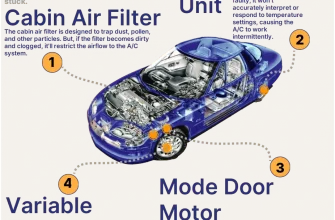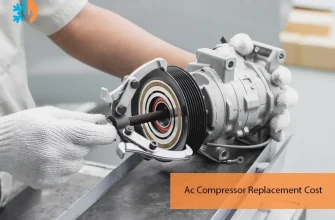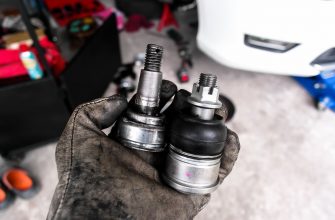The exhaust system of a vehicle plays a crucial role in controlling emissions‚ optimizing performance‚ and enhancing engine efficiency․ Understanding the various components of an exhaust system and their functions is essential for both car enthusiasts and everyday drivers․ In this article‚ we’ll delve into the key components‚ their roles‚ and how they work together to ensure your vehicle runs smoothly and cleanly․
- 1․ Exhaust Manifold
- 2․ Catalytic Converter
- 3․ Oxygen Sensors
- 4․ Exhaust Pipes
- 5․ Muffler
- 6․ Tailpipe
- 1․ Maintenance Tips for Exhaust System Components
- 2․ Upgrades for Enhanced Performance
- 3․ Environmental Considerations
- 1․ Regular Inspections and Timing
- 2․ Cleaning and Rust Prevention
- 3․ Addressing Sounds and Performance Issues
- 4․ Upgrading Exhaust Components
- The Environmental Impact
1․ Exhaust Manifold
The exhaust manifold is the first component in the exhaust system that collects the gases produced by the engine’s combustion process․ It is typically made of cast iron or stainless steel and is designed to withstand high temperatures․ The manifold directs the exhaust gases into the next stage of the system‚ ensuring efficient flow and minimizing back pressure․
2․ Catalytic Converter
The catalytic converter is a vital component for reducing harmful emissions․ It converts toxic gases such as carbon monoxide‚ hydrocarbons‚ and nitrogen oxides into less harmful substances like carbon dioxide and nitrogen․ This transformation occurs through chemical reactions facilitated by catalysts‚ usually made from precious metals like platinum‚ palladium‚ and rhodium․ A properly functioning catalytic converter is essential for meeting environmental regulations and maintaining engine performance․
3․ Oxygen Sensors
Oxygen sensors are devices that monitor the level of oxygen in the exhaust gases․ They play a critical role in the vehicle’s fuel management system by providing real-time data to the engine control unit (ECU)․ This information helps the ECU adjust the air-fuel mixture for optimal combustion․ There are typically two types of oxygen sensors: upstream (pre-catalytic converter) and downstream (post-catalytic converter)․ Both are essential for ensuring efficient engine performance and emissions control․
4․ Exhaust Pipes
Exhaust pipes are responsible for transporting the exhaust gases from the manifold to the tailpipe․ These pipes are made from durable materials‚ often stainless steel‚ to withstand high temperatures and resist corrosion․ The design and diameter of the exhaust pipes can significantly affect engine performance‚ with larger pipes often allowing for better gas flow and reduced back pressure․
5․ Muffler
The muffler is designed to reduce the noise produced by the exhaust gases as they exit the vehicle․ It uses a series of chambers and perforated tubes to dissipate sound waves‚ providing a quieter driving experience․ While the primary function of the muffler is noise reduction‚ it can also influence exhaust flow‚ which can impact engine performance․ Different types of mufflers‚ such as chambered‚ turbo‚ and straight-through designs‚ offer varying levels of sound suppression and performance enhancement․
6․ Tailpipe
The tailpipe is the final component of the exhaust system‚ directing exhaust gases out of the vehicle․ It is often the most visible part of the exhaust system and can come in various shapes and styles‚ contributing to the vehicle’s aesthetics․ While the tailpipe’s primary function is to expel exhaust gases safely into the atmosphere‚ it also plays a role in ensuring that the exhaust system maintains the correct pressure and flow dynamics․
Understanding the components of the exhaust system and their functions is essential for maintaining a vehicle’s performance and ensuring compliance with environmental standards․ Regular inspections and timely replacements of these components can help prevent costly repairs and promote a cleaner environment․ Whether you’re a car enthusiast or a casual driver‚ being informed about your vehicle’s exhaust system can enhance your driving experience and contribute to better fuel efficiency and reduced emissions․
Having established a foundational understanding of the exhaust system’s components‚ it’s essential to consider how to maintain these parts effectively and explore potential upgrades for enhanced performance․ Just as a finely-tuned orchestra produces beautiful music‚ a well-maintained exhaust system contributes to a vehicle’s overall efficiency‚ performance‚ and environmental impact․
1․ Maintenance Tips for Exhaust System Components
Maintaining your exhaust system is not just about performance; it’s also about safety and compliance with environmental regulations․ Here are some practical tips to keep your exhaust system in top shape:
- Regular Inspections: Periodically check for signs of rust‚ corrosion‚ or damage‚ especially in areas where moisture can accumulate․ Look for any unusual noises‚ which could indicate issues with the muffler or exhaust pipes․
- Check for Leaks: A leaking exhaust can lead to decreased performance and increased emissions․ Inspect the connections between the manifold‚ catalytic converter‚ and exhaust pipes for any signs of escaping gas․
- Monitor Engine Performance: If you notice a decrease in fuel efficiency‚ acceleration‚ or if the “check engine” light illuminates‚ it might be time to have your exhaust system checked by a professional․
2․ Upgrades for Enhanced Performance
For those looking to boost their vehicle’s performance‚ several aftermarket upgrades can enhance the exhaust system․ Here are some popular options:
- High-Performance Exhaust Manifolds: Upgrading to a performance manifold can improve exhaust flow‚ allowing for better engine efficiency and increased horsepower․
- Cat-Back Exhaust Systems: A cat-back system replaces the exhaust pipes from the catalytic converter to the tailpipe‚ improving airflow and often reducing weight․ This upgrade can yield a more aggressive sound and enhanced performance․
- High-Flow Catalytic Converters: Replacing the factory catalytic converter with a high-flow version can improve exhaust flow while maintaining emissions compliance‚ resulting in better engine performance․
3․ Environmental Considerations
As awareness of environmental issues grows‚ so does the importance of maintaining a clean and efficient exhaust system․ Regular maintenance not only contributes to better vehicle performance but also minimizes harmful emissions․ It’s crucial to ensure that the catalytic converter is functioning correctly and that all components are in good working order to meet environmental regulations․
The exhaust system is a vital part of any vehicle‚ influencing performance‚ sound‚ and emissions․ By understanding its components‚ maintaining them diligently‚ and considering upgrades‚ drivers can enhance their driving experience while being responsible stewards of the environment․ Whether you’re interested in keeping your car running smoothly or looking to unleash its full potential‚ paying attention to the exhaust system will yield significant rewards;
In the world of automotive excellence‚ every detail matters․ The exhaust system is not just a collection of parts; it’s an intricate network that reflects the heart of your vehicle’s performance․ Treat it well‚ and it will serve you faithfully for miles to come․
While understanding the various components of your exhaust system is crucial‚ knowing how to maintain them is equally important․ Regular maintenance not only extends the life of these components but also enhances overall vehicle performance․ Here are some essential practices to keep your exhaust system in optimal condition:
1․ Regular Inspections and Timing
It is wise to incorporate exhaust system inspections into your vehicle’s routine maintenance schedule․ Look for rust‚ corrosion‚ and any signs of physical damage․ Pay special attention to the areas around joints and connections‚ as these are often the first places to develop leaks․ Additionally‚ if your vehicle is equipped with a check engine light‚ do not ignore it; this light can often signal exhaust system issues‚ particularly related to the catalytic converter or oxygen sensors․
2․ Cleaning and Rust Prevention
Keeping your exhaust system clean can prevent long-term damage․ Regularly remove any accumulated dirt or debris‚ and consider applying a rust-inhibiting spray to metal surfaces‚ especially if you live in areas prone to road salt or heavy rain․ This simple step can help prolong the life of your exhaust system and maintain its efficiency․
3․ Addressing Sounds and Performance Issues
Unusual sounds‚ such as hissing or loud rumbling‚ can be indicators of problems within your exhaust system‚ often originating from the muffler or exhaust pipes․ If you notice a drop in engine performance‚ such as decreased acceleration or changes in fuel efficiency‚ it may be time to have a professional inspect your system․ Prompt attention to these issues can prevent more extensive repairs down the line․
4․ Upgrading Exhaust Components
For those looking to enhance performance‚ upgrading components like the muffler or catalytic converter can provide both aesthetic and functional benefits․ A performance muffler can create a more aggressive sound while improving exhaust flow‚ and a high-flow catalytic converter can enhance engine efficiency without compromising on emissions standards․ These upgrades not only elevate your vehicle’s performance but can also add a personal touch to your car’s character․
The Environmental Impact
As environmental concerns continue to grow‚ vehicle emissions are under closer scrutiny․ A well-maintained exhaust system plays a critical role in reducing harmful emissions‚ making it essential for not only the performance of your vehicle but also for the environment․ By ensuring that components like the catalytic converter and oxygen sensors are functioning correctly‚ you contribute to cleaner air and a healthier planet․ This commitment to maintenance reflects a responsible approach to vehicle ownership․









Great article! It’s amazing how all these components work together to optimize engine performance. I’ll definitely keep this in mind when maintaining my vehicle.
I found this article incredibly informative! The section on exhaust manifolds was particularly enlightening. Thanks for sharing such valuable information!
I never realized how crucial the catalytic converter is for reducing emissions. This article made it clear and easy to understand. Well done!
Fantastic breakdown of the exhaust system! The explanations are detailed yet straightforward. I appreciate how you highlighted the role of oxygen sensors.
This article provides a comprehensive overview of the exhaust system! I learned so much about the importance of each component. Great read!
I loved reading about the exhaust pipes and their function in the system. This article is a must-read for anyone interested in car mechanics. Very insightful!
This was an excellent overview of vehicle exhaust systems! I appreciate the clarity and detail provided on each component